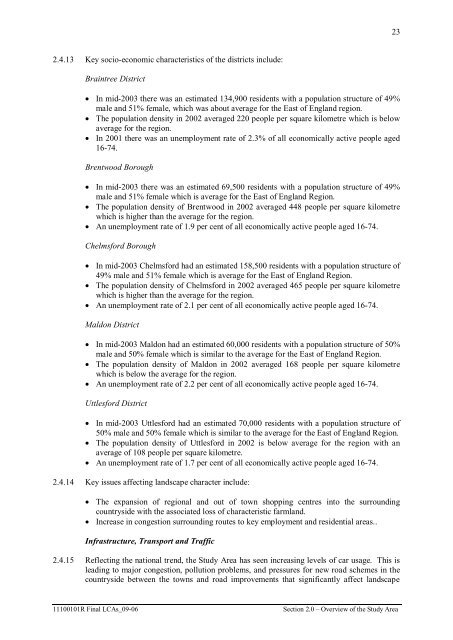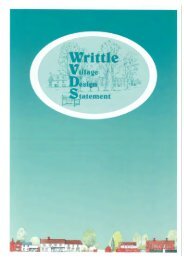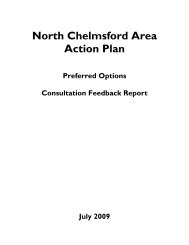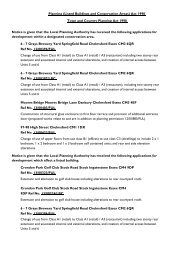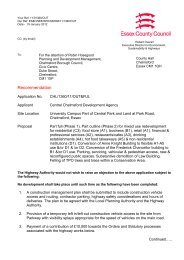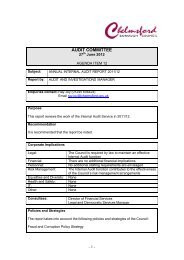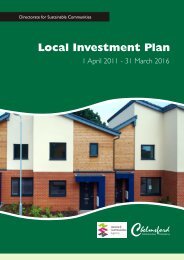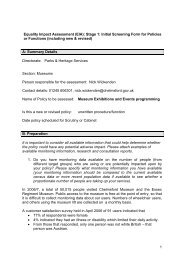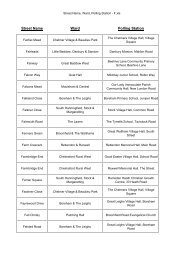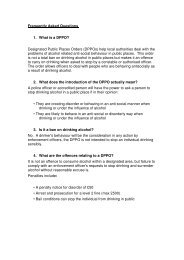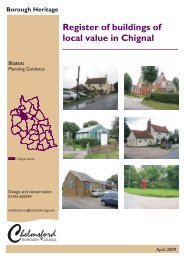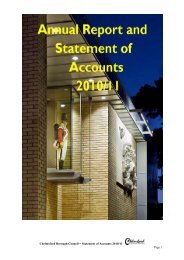22and drainage of other coastal wetland areas (through installation of a sea wall) to create areasof grazing marsh behind the sea wall. There is future pressure for further intensification ofthe coastal grazing marsh habitat, however, there is also possible future potential forsaltmarsh habitat creation and restoration through managed realignment along certainstretched of the coastline (with regard to information set out within the ShorelineManagement Plan and the Colne and Blackwater Estuary Flood Management Strategy).2.4.9 There is also potential through agri-environmental schemes such as EnvironmentalStewardship to encourage farmers to make changes to their farming practices that would helprestore the loss of important habitats and features within the landscape.2.4.10 The key issues affecting landscape character include: Decrease in woodland and tree cover. Continuing decline/loss of landscape features such as hedgerows, field margins and farmponds as a result of maximising field size, lack of appropriate management and spray drift. Loss of elms in past reducing sense of intimacy and enclosure. Soil erosion as a result of autumn cultivation of arable crops. Increased pressure for new uses of ‘marginal’ land, including small holdings, leisure usesand pony paddocks. Increase in pony paddocks giving rise to poor hedgerow and grassland management andintrusive post and wire fencing/ranch fencing, stable facilities and ménages. Loss of grazing marsh in past through arable conversion. Potential loss of limited grazing marsh back to salt marsh through managed retreat. Loss of salt marsh through coastal squeeze. Increase in large arable farm units which may lead to further homogenisation of thelandscape, reduction in biodiversity and potential demand for more centralised and largescalebuildings such as grain storage facilities. Farm diversification such as the adoption or reuse of farm buildings for commercial,industrial and storage uses which may conflict with historical/architectural character andthe introduction of new industrial crops.Socio-economic characteristics2.4.11 The social and economic characteristics of the towns in the Study Area, including<strong>Chelmsford</strong>, Braintree, Maldon, Brentwood, Witham, Great Dunmow and Saffron Waldenplay an important role in the process of future change and regeneration within the region. Inrecent years there has been a change in the structure and type of employment away fromtraditional manufacturing and agriculture to the service industries including retail, officeemployment and the high tech sector. Tourism is also a source of rural employmentespecially in the river valleys of the Colne, Blackwater, Chelmer and Brain. Commuting outof the Study Area, including to London and to Stansted Airport for employment, is alsosignificant.2.4.12 The town centres, local centres within urban neighbourhoods and village shops provide thesocial economic focus of their communities. The last ten to fifteen years have seen manychanges in retailing, including the growth of regional shopping centres, the growth of out-oftownretail parks, extended opening hours and Sunday trading, and more recently internetshopping. All of these changes have had an effect on existing town and local centres. Inparticular employment opportunities have increased significantly in the East Braintree areafollowing the success of the Single Regeneration Budget project. This has revitalised thewhole area, modernising the infrastructure, buildings new roads, bridges and cycleways,achieving environmental improvements and creating over 1,000 new jobs including those atthe Freeport Designer Outlet.Section 2.0 – Overview of the Study Area11100101R Final LCAs_09-06
232.4.13 Key socio-economic characteristics of the districts include:Braintree District In mid-2003 there was an estimated 134,900 residents with a population structure of 49%male and 51% female, which was about average for the East of England region. The population density in 2002 averaged 220 people per square kilometre which is belowaverage for the region. In 2001 there was an unemployment rate of 2.3% of all economically active people aged16-74.Brentwood <strong>Borough</strong> In mid-2003 there was an estimated 69,500 residents with a population structure of 49%male and 51% female which is average for the East of England Region. The population density of Brentwood in 2002 averaged 448 people per square kilometrewhich is higher than the average for the region. An unemployment rate of 1.9 per cent of all economically active people aged 16-74.<strong>Chelmsford</strong> <strong>Borough</strong> In mid-2003 <strong>Chelmsford</strong> had an estimated 158,500 residents with a population structure of49% male and 51% female which is average for the East of England Region. The population density of <strong>Chelmsford</strong> in 2002 averaged 465 people per square kilometrewhich is higher than the average for the region. An unemployment rate of 2.1 per cent of all economically active people aged 16-74.Maldon District In mid-2003 Maldon had an estimated 60,000 residents with a population structure of 50%male and 50% female which is similar to the average for the East of England Region. The population density of Maldon in 2002 averaged 168 people per square kilometrewhich is below the average for the region. An unemployment rate of 2.2 per cent of all economically active people aged 16-74.Uttlesford District In mid-2003 Uttlesford had an estimated 70,000 residents with a population structure of50% male and 50% female which is similar to the average for the East of England Region. The population density of Uttlesford in 2002 is below average for the region with anaverage of 108 people per square kilometre. An unemployment rate of 1.7 per cent of all economically active people aged 16-74.2.4.14 Key issues affecting landscape character include: The expansion of regional and out of town shopping centres into the surroundingcountryside with the associated loss of characteristic farmland. Increase in congestion surrounding routes to key employment and residential areas..Infrastructure, Transport and Traffic2.4.15 Reflecting the national trend, the Study Area has seen increasing levels of car usage. This isleading to major congestion, pollution problems, and pressures for new road schemes in thecountryside between the towns and road improvements that significantly affect landscape11100101R Final LCAs_09-06Section 2.0 – Overview of the Study Area
- Page 1: BRAINTREE, BRENTWOOD, CHELMSFORD,MA
- Page 6 and 7: 8.0 RECOMMENDATIONS8.1 General8.2 K
- Page 8 and 9: EXECUTIVE SUMMARYBackgroundIn Octob
- Page 10 and 11: Executive Summary iv 11100101R Fina
- Page 13 and 14: 11.0 INTRODUCTION1.1 Background and
- Page 15 and 16: 3spatial planning approach should b
- Page 17 and 18: 5Proposals Map - expresses geograph
- Page 19 and 20: 7 View types and composition Landma
- Page 21 and 22: 9 the highlighting of landscape iss
- Page 23: 2.0 OVERVIEW OF THE STUDY AREA
- Page 26 and 27: 122.2.8 On the hills above the Lond
- Page 28 and 29: 142.2.22 The Essex Estuaries cSAC i
- Page 30 and 31: 16and have been found to have been
- Page 32 and 33: 18 Medieval settlement, in the pari
- Page 34 and 35: 20Historic Environment Designations
- Page 38 and 39: 24character. Upgrading of the rail
- Page 40 and 41: 26alternative sources from outside
- Page 42 and 43: 282.5.7 Together with the Joint Cha
- Page 44 and 45: 302.5.13 The seventy Landscape Char
- Page 46 and 47: 32Section 2.0 - Overview of the Stu
- Page 49 and 50: 1395.0 LANDSCAPE CHARACTER OF CHELM
- Page 51 and 52: 141A6 UPPER CHELMER RIVER VALLEY (s
- Page 53 and 54: 143 Fourteen CWSs with unimproved g
- Page 55 and 56: 145A7 LOWER CHELMER RIVER VALLEY (s
- Page 57 and 58: 147Suggested Landscape Planning Gui
- Page 59 and 60: 149to designed character and sense
- Page 61 and 62: 1515.3 Farmland Plateau Landscapes5
- Page 63 and 64: 153and Good Easter in the lower lyi
- Page 65 and 66: 155B16 FELSTED FARMLAND PLATEAU (sh
- Page 67 and 68: 157B17 TERLING FARMLAND PLATEAU (sh
- Page 69 and 70: 159B20 WRITTLE FARMLAND PLATEAUKey
- Page 71 and 72: 161Proposed Landscape Strategy Obje
- Page 73 and 74: 163Visual Characteristics. The A12
- Page 75 and 76: 1655.4 Drained Estuarine Marsh Land
- Page 77 and 78: 167well screened in the landscape.
- Page 79 and 80: 1695.5 Wooded Farmland Landscapes5.
- Page 81 and 82: 171enclosure and tranquillity and a
- Page 83 and 84: 173F6 WOODHAM WOODED FARMLAND (shar
- Page 85 and 86: 175enclosed meadows within river va
- Page 87 and 88:
177north, south and east. Therefore
- Page 89 and 90:
179F10 HEYBRIDGE WOODED FARMLAND (s
- Page 91 and 92:
181Suggested Landscape Planning Gui
- Page 93 and 94:
183and Ramsden Heath). Church tower
- Page 95 and 96:
185F12 EAST HANNINGFIELD WOODED FAR
- Page 97 and 98:
187 Potential major road improvemen
- Page 99 and 100:
189Historic Land UseEvidence of his
- Page 101:
8.0 RECOMMENDATIONS
- Page 104 and 105:
3428.2.3 Planners, developers, arch
- Page 106 and 107:
344Drafting Core Policies and Suppo
- Page 108 and 109:
346 Make the link between planning
- Page 110 and 111:
348 change in the degree of key fac
- Page 112 and 113:
350Section 8.0 - Recommendations111
- Page 115:
APPENDIX ASTAKEHOLDER CONSULTATION
- Page 118 and 119:
with the County assessment, but sho
- Page 120 and 121:
Fit with adjacent classificationsCB
- Page 122 and 123:
Chelmsford - Key threats to valued
- Page 124 and 125:
Appendix A - Stakeholder Consultati
- Page 126 and 127:
CBA gave a brief overview of the st
- Page 128 and 129:
9. Summary and Recommendations/Appl
- Page 130 and 131:
development planning with conservat
- Page 133 and 134:
GLOSSARYCommunity StrategyAll local
- Page 135:
APPENDIX CSOURCES OF FURTHER INFORM
- Page 138 and 139:
English Heritage, 2003, Register of
- Page 141 and 142:
HISTORIC LANDSCAPE CHARACTER AREAS
- Page 143:
APPENDIX ECURRENT LOCAL PLANNING SI
- Page 146 and 147:
Appendix E - Current Local Planning
- Page 149 and 150:
APPENDIX FDRAFT CORE STRATEGY LANDS
- Page 151:
cbawww.cba.uk.netLondon OfficeSwan


